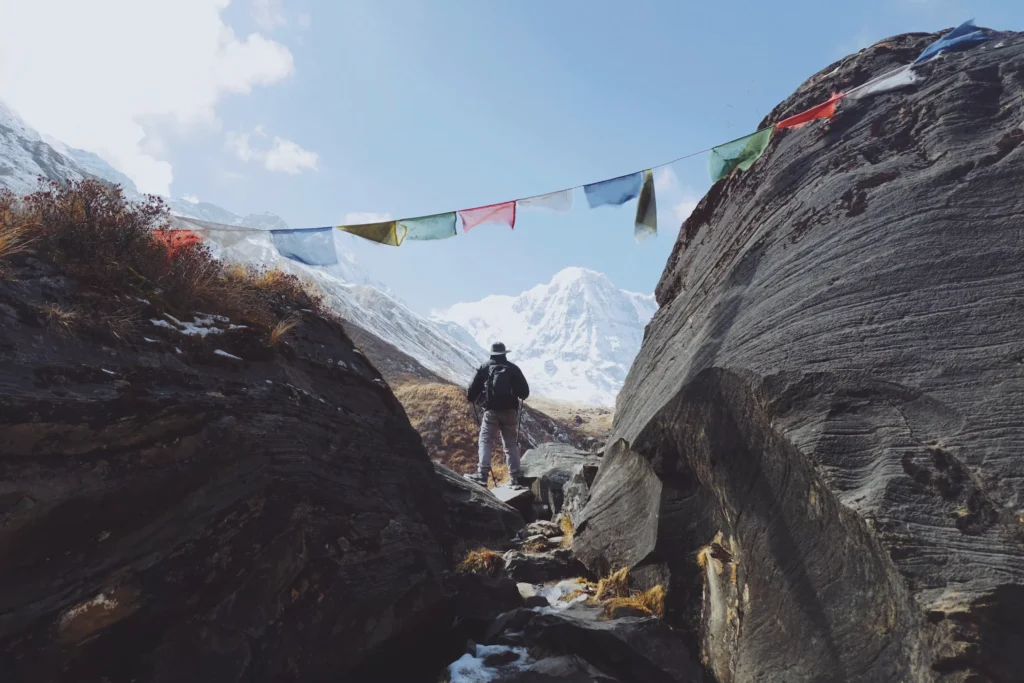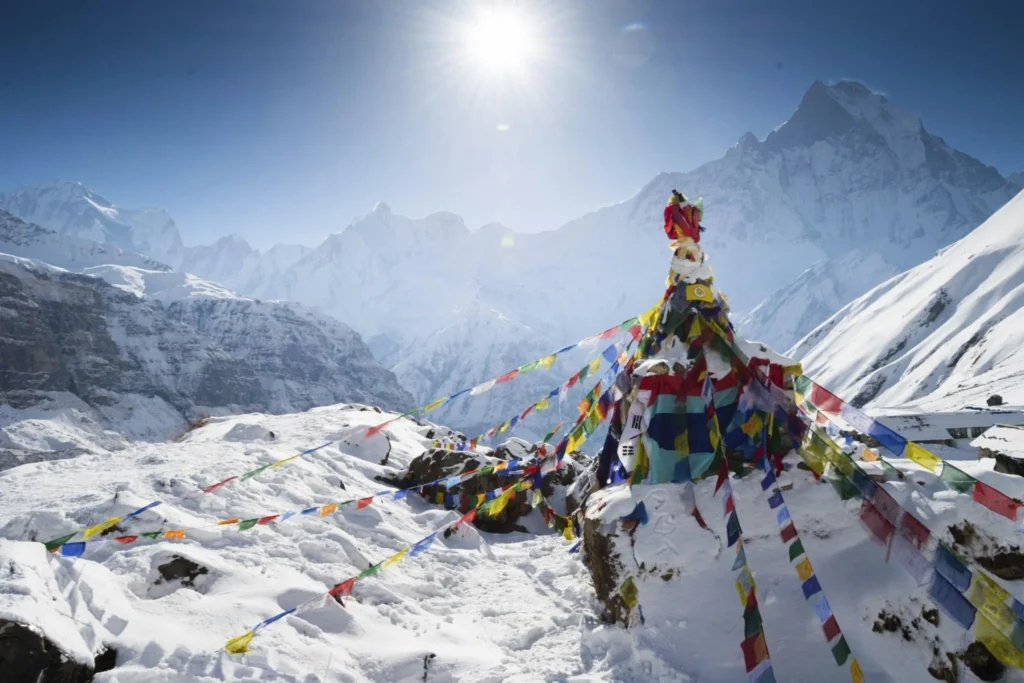Imagine a journey where every step brings a new wonder. The Annapurna Sanctuary awaits you. This trekking paradise in the Himalayas offers more than just a walk. It’s an adventure calling your name. Picture yourself amidst towering peaks and vibrant cultures. This blog will guide you through it all.
It’s a blend of breathtaking views and rich culture. Here, you’ll find nature at its finest. Snow-capped mountains, lush forests, and rare wildlife. It’s a favorite for tourists seeking beauty and challenge. Join us to explore why this sanctuary is a must-visit for every traveler.
Why Choose Annapurna Sanctuary for Your Trek?
Annapurna Sanctuary offers a unique trekking experience. It’s less crowded than other popular treks in Nepal. This means more peace and a chance to connect with nature.
The trek showcases diverse landscapes. You’ll see forests, mountains, and local villages. The path is also less traveled. This gives a more authentic feel of Nepal’s culture.
It is shorter and less challenging than others. Yet, it still offers stunning views of the Himalayas. It’s perfect for those who want a mix of adventure and culture in a shorter time.
How To Get Annapurna Sanctuary?
To reach Annapurna Sanctuary, start by flying to Nepal. Kathmandu, the capital, is the main entry point. From there, travel to Pokhara. This is the gateway to Annapurna. You can fly or take a bus. The flight is quick, about 30 minutes.
The bus journey takes about 6-7 hours but offers scenic views. Once in Pokhara, local transport options vary. You can take a taxi or a local bus to reach the trek’s starting point.
These local transports are affordable and available from Pokhara. They take you to the trek base, where your adventure begins.

Best Time to Trek Annapurna Sanctuary
Annapurna Sanctuary has two main trekking seasons. These are spring and autumn.
Month-by-Month Weather Conditions
From March to May, it’s spring. The weather is mild. Days are warm, and nights are cool. This season brings clear skies and blooming flowers. From September to November, it’s autumn. The monsoon rains have passed. The weather is dry with stable temperatures. Views are clear.
Recommended Times for Optimal Experience
The best times to trek are April, May, October, and November. These months offer the best balance of good weather and clear views. Trails are also less crowded. These conditions make for a safer and more enjoyable trek.
The Annapurna Sanctuary Trek: Your Day-by-Day Guide
Join us on the Annapurna Sanctuary Trek, a day-by-day guide to an incredible Himalayan adventure.
Day-by-Day Breakdown
| Day | Route | Distance | Elevation |
| 1 | Pokhara to Nayapul (1,070m) | 9 km | 1,070m |
| Trek to Tikhedhunga (1,540m) | 1,540m | ||
| 2 | Tikhedhunga to Ghorepani (2,850m) | 13 km | 2,850m |
| 3 | Ghorepani to Poon Hill (3,210m) | 9 km | 3,210m |
| Then to Tadapani (2,610m) | 2,610m | ||
| 4 | Tadapani to Chhomrong (2,170m) | 10 km | 2,170m |
| 5 | Chhomrong to Bamboo (2,310m) | 7 km | 2,310m |
| 6 | Bamboo to Deurali (3,230m) | 8 km | 3,230m |
| 7 | Deurali to Annapurna Base Camp (4,130m) | 7 km | 4,130m |
| 8-10 | Return trek to Pokhara | ||
| via Bamboo, Jhinu Danda, and Nayapul |
Key Locations and Distances
The trek covers key locations like Ghorepani, Poon Hill, Tadapani, and Chhomrong. Each day involves trekking 7 to 13 km. The journey includes diverse landscapes and cultural experiences.
Altitude Information and Acclimatization Tips
- Start at lower altitudes and gradually ascend.
- Spend a night in Ghorepani and Deurali for acclimatization.
- Watch for altitude sickness symptoms.
- Stay hydrated and avoid overexertion.
- Listen to your body and rest when needed.
This itinerary offers a balanced trek with time for acclimatization. It ensures a safe and enjoyable experience in the Annapurna Sanctuary.

Annapurna Sanctuary Trek’s Difficulty and Required Fitness Level
Curious about the Annapurna Sanctuary Trek’s difficulty and fitness requirements? Let’s find out
Physical Demands of the Trek
The Annapurna Sanctuary Trek is moderate in difficulty. It involves daily walks of 5-7 hours. The path includes uphill and downhill trails. High altitude adds to the challenge. Good stamina and physical fitness are important.
Pre-Trek Training and Preparation Tips
Start training a few months before. Include cardio exercises like running and cycling. Add hill walking to your routine. Strengthen your legs with squats and lunges. Practice long walks with a backpack. This prepares your body for the trek’s demands.
Health and Safety Considerations
Stay hydrated and eat well. Listen to your body. If you feel tired, take breaks. Be aware of altitude sickness symptoms. Carry a basic first aid kit. Inform your guide if you feel unwell. Always follow the guide’s advice for safety.
This trek requires good fitness but is achievable with proper preparation. Pay attention to your health and safety for a successful trek.
Accommodation and Meals
On the Annapurna Sanctuary Trek, you’ll stay in teahouses. These are small, family-run lodges. They offer basic rooms, often with two beds. The facilities are simple. Some places have shared bathrooms.
For meals, teahouses serve local and international dishes. Expect dal bhat (rice and lentils), noodles, and soup. They also offer pancakes and eggs for breakfast. Vegetarian options are available.
Meals are hearty and designed to fuel your trek. Remember, as you go higher, prices may increase slightly. This is due to the cost of transporting goods to these remote areas.
Permits and Legal Requirements
For the Annapurna Sanctuary Trek, you need two permits.
- Annapurna Conservation Area Permit (ACAP): Required for all trekkers.
- Trekkers’ Information Management System (TIMS) Card: Essential for safety and management.
You can get these in Kathmandu or Pokhara. They require passport details and photos. The cost varies for different nationalities. These permits help in conservation efforts and ensure trekker safety. Keep them with you during the trek.
Packing Essentials for Annapurna Sanctuary
When packing for the Annapurna Sanctuary, keep it simple.
Clothing:
- Thermal layers for cold weather.
- Waterproof jacket and pants.
- Trekking boots and socks.
- Hat and gloves.
Gear:
- Backpack with rain cover.
- Sleeping bag suitable for cold temperatures.
- Headlamp with extra batteries.
Health and Hygiene:
- Basic first aid kit.
- Sunscreen and lip balm.
- Hand sanitizer and wet wipes.
Navigation and Tools:
- Map of the trekking area.
- Compass or GPS device.
Food and Water:
- Water bottles or hydration system.
- Snacks like energy bars.
Miscellaneous:
- Sunglasses.
- Camera with extra batteries.
- Trekking poles.
Cultural Insights: Local Villages and People
In the Annapurna region, local villages are full of rich culture. People live in close-knit communities, often in large family groups. Their life is simple, focused on farming and animals.
Tradition is key in daily life. Festivals and rituals are common and important. The locals are warm and welcoming to trekkers. They often invite visitors into their homes. Nepali is the main language, but local dialects are also spoken.
FAQs
How long does the Annapurna Sanctuary trek take?
Typically 10-14 days, depending on the chosen route.
Is the trek suitable for beginners?
Yes, with proper preparation and a moderate fitness level.
Are there altitude-related risks on the trek?
Yes, altitude sickness is a concern; acclimatization is key.

